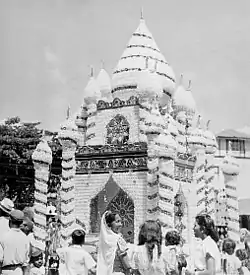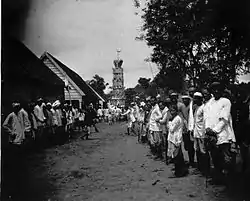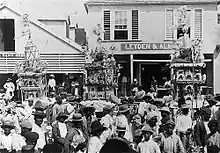Hosay
Hosay (originally from Husayn) is a Muslim Indo-Caribbean commemoration that is popularly observed in Trinidad and Tobago, Guyana, Suriname, and Jamaica. In Trinidad and Tobago, multi-colored model mausoleums or mosque-shaped model tombs known as tadjah are used to display the symbolic part of this commemoration. They are built and paraded, then ritually taken to the sea on last day of observance, and finally discarded into the water.[1] The word tadjah derived from the Arabic word ta'zieh and signifies different cultural meanings depending on the region, time period, occasion, and religion. In British Guiana, (now called Guyana), and Suriname, the festival was called Taziya or creolized into tadjah in reference to these floats, arguably the most visible and decorative element of this festival.
| Hosay | |
|---|---|
| Also called | Hussey, Ashura, Coolie Carnival (historically) |
| Observed by | Shi’a and some Sunni Indo-Caribbean Muslims in Trinidad and Tobago, Guyana, Suriname, Jamaica, and their diaspora |
| Frequency | Annually |
| Related to | Ashura, Mourning of Muharram, Tabuik, Tabot, The Day of Atonement |


Generally, Hosay lasts for ten days and is observed in accordance with the Islamic lunar calendar and in line with ten days of Ashura commemorated by Shia Muslims throughout the world. The last four days are the most popular as the first six days are days of fasting, prayer and building of the "Tadjahs" and "Moons".[2][3] Although Hosay was traditionally commemorated for Husain, its celebration in recent times has adopted all types of shades and characters from Sunni Islam and other religions including Hindus and Christians making the modern event a mixture of different cultures and religions. The event is attended by both Muslims and non-Muslims, depicting an environment of mutual respect and tolerance. A unique design of tadja can be found during the Hosay celebrations in Cedros, a coastal village situated in the South-Western end of Trindad, that are built in an exclusive style that is not found anywhere else in the world, in terms of the art and style of construction.[4][5] In nineteenth-century Trinidad newspapers as well as government reports called Hosay the "Coolie Carnival."[6]
Origins
The Hosay (derived from Husayn or Hussein)[7] celebration is a Caribbean manifestation of the Shia Muslim Remembrance of Muharram in Trinidad and Tobago[8] and Jamaica[9] (where is it spelled Hussay). The name Hosay comes from "Husayn" who was assassinated by Yazid in Karbala. This martyrdom is commemorated in the festival. In Trinidad and Tobago it is primarily celebrated in Saint James, in northwestern Trinidad and in Cedros in southwestern Trinidad. Recently it has been revived elsewhere. In Jamaica it is celebrated throughout the island. In the past, every plantation in each parish celebrated Hosay. Today it has been called an Indian carnival and is perhaps most well known in Clarendon where it is celebrated each August. People of all religions attend the event.[10][11]

In the 1850s, very elaborately decorated models of mosques made of paper and tinsel called {{lang|mis|tadjahs{{lang|mis| were carried through the streets to the accompaniment of constant drumming. Small fires were lit in the gutters beside the streets over which the drumskins were heated to tighten the skins of the tassa drums. Mock stick fights celebrate the martyrdom of Husayn ibn Ali. The festival lasts three days ending with the throwing of the tadjahs into the sea at sunset on the third day. Although Hosay is a religious event for Shias, all of Trinidad's religious and ethnic communities participate in it, and it has become accepted as part of the national culture.
The Remembrance of Muharram was continued to the Caribbean by Muslim indentured labourers and other migrant laborers from India. Hindu and Muslim Indians, who emphasized their common culture and celebration over religion, namely from Indian Gujarat, Rajasthan, Bihar, Madras as well as the provinces of Oudh and City of Lucknow, are essential to this celebration. These people entered Guyana in 1838, and Trinidad after 1845, from colonial India under British auspices (see Indo-Caribbean people). The observance of Hosay in Trinidad is traced back to 1854.[12]
Suppression
In the 1880s the British colonial authorities became increasingly concerned about public gatherings, and in 1884 issued an ordinance to prevent the public Hosay commemorations. Thousands of workers, who had spent the year building their tadjahs joined a Hindu named Sookhoo, in petitioning the government to allow the festival per their agreement with the Governor, who was visiting London during this episode. When all appeals were ignored by the Protector of Immigrants, through ignorance of the new July 1884 prohibition, defiance, or both, the tadjahs were taken onto the streets at the appointed time, and in order of the estates. The first estate that took its tadjah onto the street had earned that right over the past months, and in some towns, Hosay went ahead. In Port-of-Spain (St. James) the police did not interfere, but in Mon Repos, San Fernando, on Thursday, October 30, 1884, buckshot was fired into the crowds of women, children and men. After shots were fired by the police to disperse the procession, 22 "Indians" were killed immediately. Later, 120 were found with injuries, some of whom had run into the cane fields to hide during the police attack. That day is commonly referred to in Trinidad history as the Muhurram Massacre by Indians and as the Hosay Riots in British and colonial records.
See also
References
- Hope, Green (26 March 1999), "BU prof wins mini-Oscar for film of ethnic rituals", B.U. Bridge Vo. II No. 28, Boston University
- Dr. Fiazuddin, Shuayb (2015), Hosay in Trinidad and Tobago: History, Cultural Transformations, and Meanings, Lecture outreach program, JAWDA Institute Inc, in collaboration with Consulate General of Trinidad and Tobago in New York, pp. 1–12 PDF link
- "Festivals and Holidays". Government of the Republic of Trinidad and Tobago. Retrieved January 6, 2017.
- "Hosay in Cedros". Trinidad Express. March 15, 2015. Retrieved January 6, 2017.
- Jevan Soyer (2016). "Hosay in St. James – then and now". Sweet TnT Magazine. Retrieved January 6, 2017.
- Specifically, Trinidad Sentinel 6 August 1857. Also, Original Correspondence of the British Colonial Office in London (C.O. 884/4, Hamilton Report into the Carnival Riots, p.18
- Ronald C. Emrit. "Hosay (Hussain)". Cultural and Sports History of Trinidad & Tobago. Retrieved January 6, 2017.
- Korom, Frank J. (2003). Hosay Trinidad: Muharram Performances in an Indo-Caribbean Diaspora. University of Pennsylvania Press, Philadelphia. ISBN 0-8122-3683-1.
- Shankar, Guha (2003) Imagining India(ns): Cultural Performances and Diaspora Politics in Jamaica. Ph.D. Dissertation, University of Texas, Austin pdf Archived 2008-12-19 at the Wayback Machine
- "Hosay Festival, Westmoreland, Jamaica".
- "Out Of Many Cultures The People Who Came The Arrival Of The Indians".
- Dr Kumar Mahabir (May 29, 2012). "Indian arrival and survival". Trinidad Express Newspapers. Retrieved January 7, 2017.
Footnotes
- Mendes, John. 1986. Cote ce Cote la: Trinidad & Tobago Dictionary. Arima, Trinidad.
